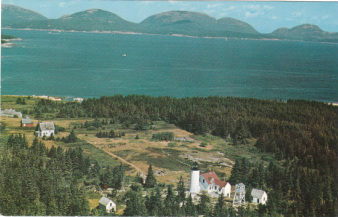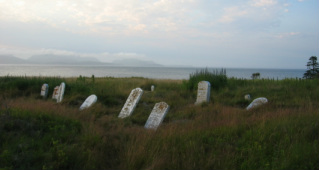The History of Baker Island
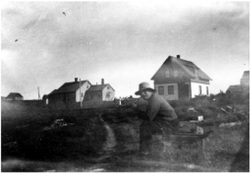
Charles Gilley (ANP Image)
The story of Baker Island represents that of many islands and coastal settlements. Rugged topography and climate demanded perseverance and resourcefulness of its citizens. While maritime travel was more efficient in many ways than by land, it posed hazards and challenges of its own. Changing political landscape, and technological advances affected remote communities. Understanding and reflecting on the story of Baker Island may shed light on broader aspects of regional history, place and community.
Gilley Settlement
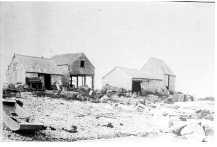
Gilley fish houses (ANP image)
William and Hannah Lurvey Gilley settled the island in about 1806, with two or three children; by 1826 their family grew to six sons and six daughters. The Gilleys survived as did many seafaring farmers of the time: eating birds, fish, wild and cultivated foods. Island livestock included sheep, hogs, cattle and poultry. Markets in New York and Boston bought cobblestones, feathers, and smoked herring, while butter and eggs were sold in SW Harbor.
Growing Family
As the Gilley offspring married, some left the island, but two sons--Elisha and Joseph-- remained on Baker. Each took a bride (Hannah and Adeline, respectively), and a combined 13 Gilley grandchildren were raised, four of whom stayed (two as bachelors; two with families of their own). By 1840 there were three households, and throughout the 19th century the population hovered around 20 in 3 or 4 households. After 1900, the population declined; the last of the Gilleys moved away or died by 1930.
Growing Family
As the Gilley offspring married, some left the island, but two sons--Elisha and Joseph-- remained on Baker. Each took a bride (Hannah and Adeline, respectively), and a combined 13 Gilley grandchildren were raised, four of whom stayed (two as bachelors; two with families of their own). By 1840 there were three households, and throughout the 19th century the population hovered around 20 in 3 or 4 households. After 1900, the population declined; the last of the Gilleys moved away or died by 1930.
Government Presence
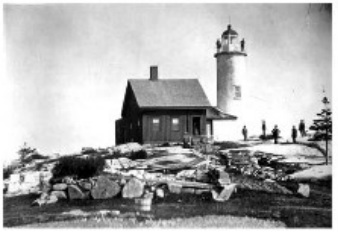
Baker Light, c. 1859
(ME Hist Pres Comm/
NARA photograph)
In 1828, the U.S. Lighthouse Service built a lighthouse and keeper’s house, at a cost of $3,798.26. William Gilley was appointed as the first keeper[the foundation of this first keeper's house is at the base of the rise to the current house], but was replaced in 1848 because, it is said, he refused to join the Whig Party in office. He moved to Duck Island to raise sheep; hard feelings may have remained with their offspring. The subsequent keeper, John Rich, was not graciously welcomed by the Gilleys. In 1853, "the Secretary of the Treasury directed that legal steps be taken to eject the trespassers." The attempts of the USLS to have the Gilleys removed from Baker Island were unsuccessful. An agreement was struck giving the Government right of way from the landing up to the lighthouse, and set aside 19 acres for the lighthouse complex. By this time, Gilley - Keeper relations had much improved; due in part, perhaps to the fact that the next three were Bunkers... relatives of the Gilleys (starting with Joseph, William's brother-in-law and "the boys'" uncle)!
In 1855, the current lighthouse and keeper’s house were built. The Gilleys were challenged once again in 1898, but prevailed in a Portland court. The Attorney General ruled that "It would be unfair and oppressive...to assert the paramount title of the Government against the few poor and hardy fishermen living there; and if the United States has and intends to allow them to take peaceable possession of these scant and sterile lands, I can see no earthly objection to allowing the town of Cranberry Isles to build a school house for the proper education of their youth."
Other government installations over the years have included a U.S. Signal Service facility, possibly manned during the Spanish American War and again in WWI. During WWII, a watch tower was erected in 1942 at about the same site, and was manned by Guardsmen.
In 1955, the light was deactivated- but reactivated as an automated aid to navigation two years later, after outcry by local mariners. The Coast Guard still maintains the light, but in 2011 transferred ownership of the tower to the National Park Service, which owns all but the two red buildings.
In June 2017, the light was updated with installation of a solar-powered Vega VLB 44 (LED).
Spruce Encroachment
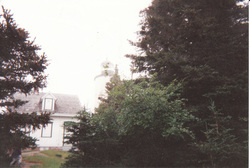
Overgrown light, c.1990
The latter half of the 20th century has seen encroachment of dense spruce forest such that the value of the light has been questioned as an Aid to Navigation. Suggestions of decommissioning in 1991 and 1997 elicited resounding protests, evidence of the place Baker Island holds in the hearts of many, and its continued value as an ATN.
New Era of Stewardship
Keepers of Baker Island is a 501(c)3 nonprofit corporation formed to support the Park Service with its continued management of this precious resource. Drawing on a wide base of support from visitors, local organizations, residents, and the Park itself, KOBI hopes to facilitate the care and upkeep of Baker’s natural and cultural landscape, and honor the history of the many seafaring agrarian settlers of the past.
